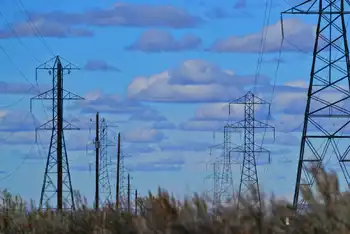Industry looks to LEDs for homes
By New York Times
Substation Relay Protection Training
Our customized live online or in‑person group training can be delivered to your staff at your location.

- Live Online
- 12 hours Instructor-led
- Group Training Available
This lamp from Nexxus Lighting uses less than 8 watts and is said to be as bright as a 75-watt incandescent bulb. Price: $100.
LED bulbs and fixtures dominated nearly every booth on the show floor.
Now all the world has to do is catch up. Most people think of LEDs as the lights blinking from inside electronic devices. They are being used increasingly to light rooms, though few people have ever bought them.
“In the U.S., 78 percent of the public is completely unaware that traditional light bulbs will be phased out in 2012,” said Charles F. Jerabek, president and chief executive of Osram Sylvania, a unit of Siemens. By law, bulbs must be 30 percent more efficient than current incandescent versions beginning that year.
While the current crop of compact fluorescents could do the job, the industry is rallying around LED lamps for many applications. They say LEDs last longer than current bulbs and compact fluorescent ones and their energy consumption could eventually be less than fluorescent lightsÂ’. They can also be made in many shapes and sizes, which was evident at the trade show. Unlike compact fluorescents bulbs, they contain no mercury and they work well in cold weather. They provide a more pleasing light than fluorescents.
Manufacturers displayed LEDs incorporated into large warehouse, garage and street-lighting fixtures, flexible light ribbons, and replacements for the halogen reflector lamps used in kitchens and offices. Strips of flexible LEDs from Osram Sylvania put light in places where it could not otherwise fit. Later this year, the company will market tiny LED chandelier lights that use 6 watts instead of the 15 watts typical of an incandescent version. It says they will last 25,000 hours instead of 1,500 for an incandescent bulb. Also this fall, Osram, Lighting Science and Philips will introduce 25,000-hour LED lamps that look like traditional bulbs but use just 8 watts of electricity to produce the same amount of light as a 40-watt bulb.
Much of the industryÂ’s effort is aimed at making LED lamps that emit as much light as a 60- or 75-watt incandescent bulb. Cree, a leading maker of LEDs, showed a new version of its LED ceiling fixture that uses 6.5 watts, compared with 11 watts for last yearÂ’s model, to create the light of a standard 65-watt lamp.
Even with the wide range of LED products now available, compact fluorescent bulbs will be the technology of choice for most consumers for years to come. That is a result of LEDs’ high prices — more than $20 for a 40-watt-equivalent bulb — and the difficulty in creating bright bulbs. “The C.F.L. market still has a lot of growth,” said Michael B. Petras Jr., president of GE Lighting, a unit of General Electric. Even so, the company is devoting 50 percent of its research and development money to LED-related technologies.
The advent of long-lasting bulbs means light bulb companies have to shift away from making most of their money selling replacement bulbs. Over the last several years, Philips has remade itself by acquiring several companies that sell lamp fixtures for homes and businesses.
The company expects its LED sales in the United States to increase to $200 million this year from $120 million in 2008, according to Kaj den Daas, president of PhilipsÂ’s lighting group for the United States.
The industry expects to sell more bulbs at a higher price. “Instead of $1.25 light bulbs, we’ll be selling $10 to $20 systems,” said Mr. Jerabek of Osram Sylvania. He also said today’s larger homes have many more lights than homes 20 years ago. And, as LED energy efficiency improves, he thinks consumers will upgrade their LED fixtures with lower watt versions.
Mr. Jerabek remembers the recent debacle with the introduction of low-price compact fluorescent lamps. Their poor reliability and unnatural light caused widespread dissatisfaction among consumers.
“It will be a huge injustice and setback if we allow the same thing to happen to LEDs,” he said.











